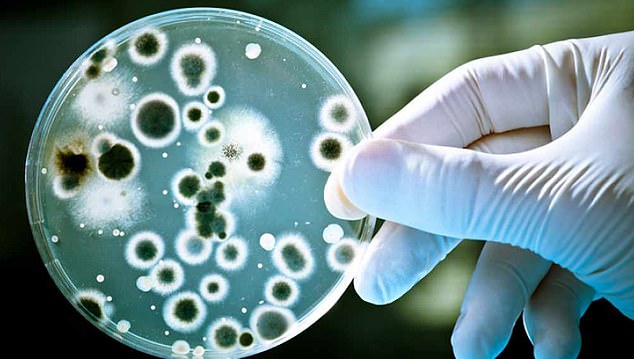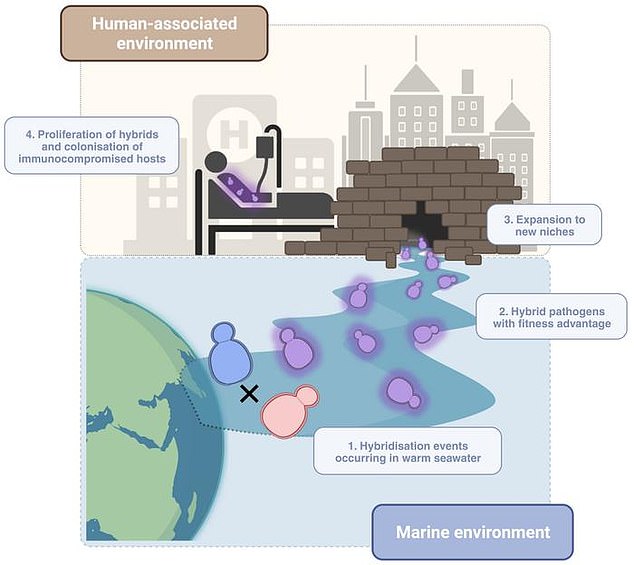Climate crisis could spark deadly fungus outbreaks like HBO’s ‘The Last of US’: Scientists warn of ‘hybrid’ evolving to adapt to warmer temperatures
>
Scientists have warned that HBO’s The Last of Us series has moved one step closer to reality after the discovery of a new hybrid mushroom.
Scientists in Barcelona said that osteochondrosis arose from two parental lineages in a rare event called hybridization as a result of climate change.
The new super strain has acquired specific characteristics, such as infecting the human body, growing at higher temperatures, and resistance to antifungal drugs.
The researchers said hybrids could become more common as temperatures rise and changes in ecosystem conditions, along with globalization and human activity, such as the extensive use of fungicides and antibiotics in agriculture.
HBO’s The Last of Us may be a fantasy series, but scientists have identified a hybrid fungus with the potential to threaten global health.
Lead researcher Dr Toni Gabaldon from the Institute of Biomedical Research (IRB Barcelona) said: “We have spent years trying to answer the question of what makes some species pathogenic to humans and others, such as those in our microbiome and not those in our microbiome.” .
“Our results show that hybridization – a process that has received little attention so far – allows rapid acquisition of characteristics that allow human infection. Therefore, in fungi, this process could be a shortcut to overcoming a species like ours.”
During hybridization, divergent genomes and alleles are brought together in the same cell, promoting adaptation by increasing genomic plasticity.
Divergent genomes are when mutations accumulate in populations of two or more ancestral species over time.
An allele is one of two or more alternative forms of a gene that arise by mutation and are found at the same place on the chromosome.
“Indeed, with due caution, this is the plot of the recent and popular miniseries “The Last of Us” (HBO Max), in which a fungus rapidly acquires enormous infectivity, transmission and virulence, a perfect combination of properties. Allowing it to annihilate humanity in real time. short.

The newly discovered fungus is part of the Candida family that causes infections such as vaginal candidiasis or systemic candidiasis, which can be fatal in immunocompromised people.

The new super strain has acquired specific characteristics, such as infecting the human body, growing at higher temperatures, and resistance to antifungal drugs.
It is estimated that there are currently more than a million species of fungi, most of which are adapted to live at moderate or low temperatures in soil, aquatic environments, trees, plants, and animals such as amphibians, fish, reptiles, and insects.
One parental lineage has been identified within the hybrid fungus, which was transmitted through… Enriched membrane and cell wall-associated proteins, which could play a role in virulence, adhesion and pathogenesis.
It also required the ability to grow at a faster rate.
“The presence of parent B in symbiosis with several previously identified hybrid branches suggests that a warm seawater environment could be a melting pot for these two lineages,” the study published in nature.
“We have seen that the ideal temperature at which C. orthopsilosis strains grow is 35 degrees Celsius, and they can survive even much higher temperatures,” said Dr. Valentina del Olmo.
“This observation is worrying because its tolerance exceeds the thermal barrier of mammals, which until now has served as a protective shield, and paves the way for infection in humans.”
The team shared in a press release that C. orthopsilosis appears to be closely related to Candida auris, which is currently sweeping through U.S. medical facilities.
The team said they believe C. Auris is also a hybrid that formed in the sea and jumped to humans in 2009.
Hundreds of outbreaks of this infection have already occurred around the world, with the fatality rate ranging between 30 and 60 percent.
Scientists suggest that it could be the first microorganism to become pathogenic due to climate change.
In this work, the team studied nine Arabian Sea yeast samples isolated from the marine environment, specifically off the coast of Qatar, and found that almost all of them were hybrids.
C. orthopsilosis strains have also been recently isolated from tea flowers in Thailand but were not used in this study.
This observation led them to hypothesize that these fungi may have undergone adaptations that give them an advantage over their parental strains.
(tags for translation)dailymail
